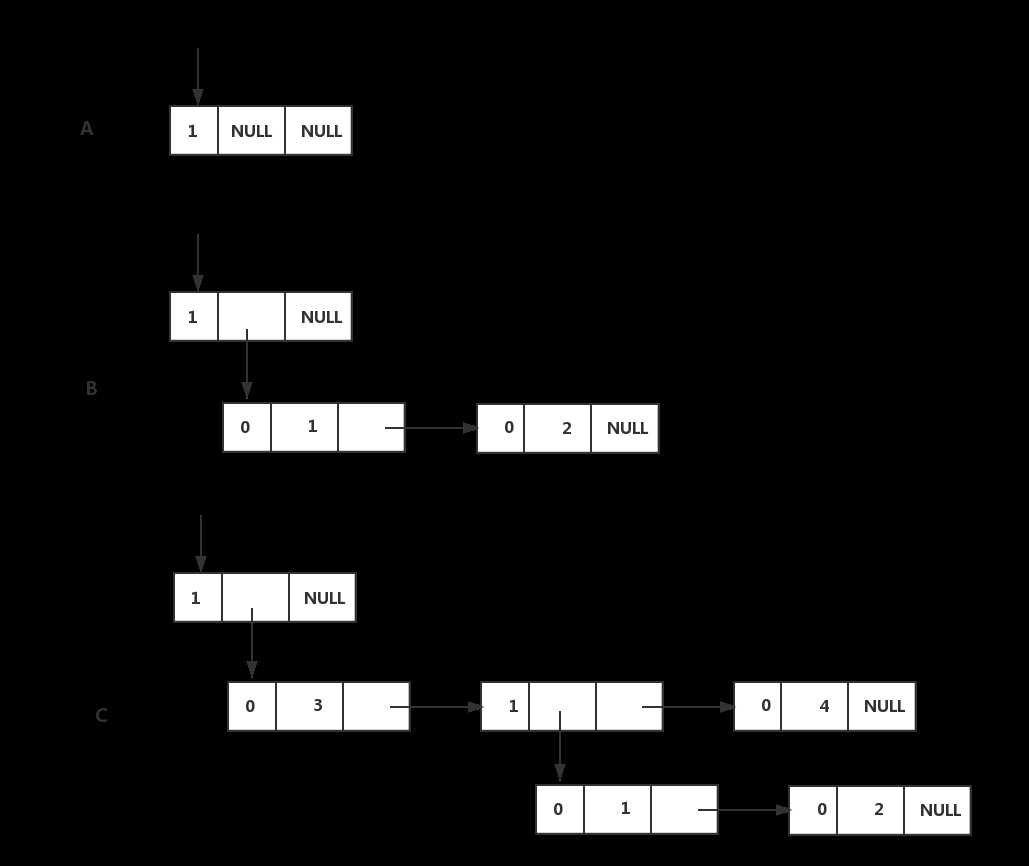标签:
Python中的list就是一种广义表,使用起来非常方便。广义表的特点就是能够存储不同类型的元素,也支持嵌套使用,即表中还有表。关于广义表的定义还有几本操作归纳如下:
ADT Linear List:
元素组成:
能存储不同元素类型的表结构叫做广义表,支持嵌套操作。
基本操作:
InitGList() 创建一个空表
DestoryGList() 销毁一个表
GListLength() 获取表的长度
GListDepth() 获取表的深度
PrintList() 遍历一次表
InsertList() 插入操作
DeleteList() 删除操作
广义表的特点使得其使用链式结构来实现较方便,那用什么样的结构来表示广义表中的元素呢?它必须同时支持普通元素也能够表示表结构。需要使用一个标志符来说明是普通元素还是表,如果是普通元素,则接下来存储它的值,如果是表结构,则存储指向该表的指针。最后再是一个指向下一个元素的指针。其定义如下:
typedef enum {ATOM, LIST}ElemTag; typedef struct GNode { ElemTag tag; union { int data; struct GNode *head; }; struct GNode *next; }GList;
下面通过几个例子的示意图来更好的理解。
A = [] // A是一个空表
B = [1, 2] // B存储两个普通元素
C = [3, B, 4] // C既有普通元素也有表

下面是用C语言来实现的广义表定义还有一些基本的操作。
/* * * * this file is to define and release GList struct * * * * */ // GList node #include <stdio.h> #include <stdlib.h> typedef enum {ATOM, LIST}ElemTag; typedef struct GNode { ElemTag tag; union { int data; struct GNode *head; }; struct GNode *next; }GList; GList *InitGList() { GList *phead = NULL; if ((phead = (GList*)malloc(sizeof(GList))) == NULL) { printf("malloc failed\n"); return NULL; } phead->tag = LIST; phead->head = NULL; phead->next = NULL; return phead; } int GetGListLength(GList *phead) { int len = 0; if (phead == NULL || phead->head == NULL) return len; phead = phead->head; while (phead != NULL) { len += 1; phead = phead->next; } return len; } int GetGListDepth(GList *phead) { int depth = 0; int tmp = 0; if (phead == NULL || phead->head == NULL) return depth; phead = phead->head; while (phead != NULL) { if (phead->tag == ATOM) tmp = 1; else tmp = GetGListDepth(phead) + 1; depth = tmp > depth ? tmp : depth; phead = phead->next; } return depth; } void PrintGList(GList *phead) { if (phead == NULL || phead->head == NULL) return; phead = phead->head; while (phead != NULL) { if (phead->tag == ATOM) printf("%d\n", phead->data); else PrintGList(phead); phead = phead->next; } } GList *InsertGList(GList *phead, GList *pinsert, int position) { if (phead == NULL || phead->head == NULL) return; int len = GetGListLength(phead); if (position < 1 || position > len + 1) { printf("the position is not right\n"); return; } GList *ptmp; if (position == 1) { ptmp = phead->head; phead->head = pinsert; pinsert->next = ptmp; return phead; } phead = phead->head; int i; for (i = 1; i < position - 1; i++) phead = phead->next; ptmp = phead->next; phead->next = pinsert; pinsert->next = ptmp; return phead; } GList *DeleteGList(GList *phead, int position) { if (phead == NULL || phead->head == NULL) return; int len = GetGListLength(phead); if (position < 1 || position > len) { printf("the position is not right\n"); return; } GList *ptmp; if (position == 1) { ptmp = phead->head; phead->head = ptmp->next; free(ptmp); return phead; } phead = phead->head; int i; for (i = 1; i < position - 1; i++) phead = phead->next; ptmp = phead->next; phead->next = ptmp->next; free(ptmp); return phead; }
标签:
原文地址:http://www.cnblogs.com/Gru--/p/5011358.html